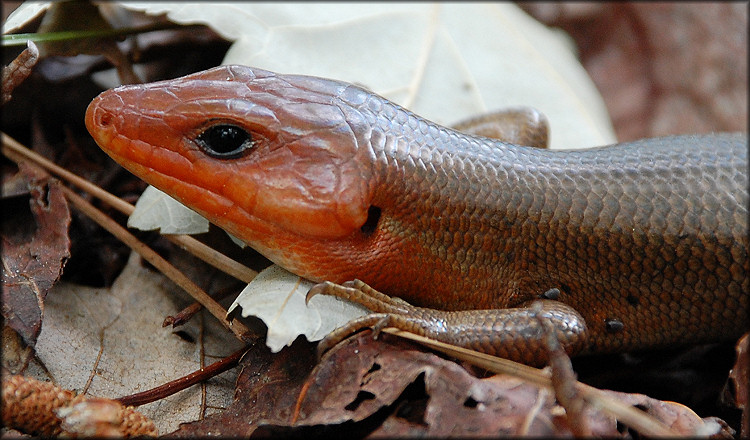
by Erik Lovestrand | May 26, 2022
Well, the answer to this question should be obvious, right? However, when we take a closer look at these interesting creatures, the first impression created by their frightful name will likely evaporate completely. First, scorpions are considered venomous, rather than poisonous (I know, a technicality). They have many predators that eat them with no ill effect so they are not poisonous. Anything that has the ability to deliver a toxin by means of injection is classified as venomous. Next, the name is a true misnomer because the group of animals referred to as blue-tailed scorpions are actually a type of lizard called a skink.
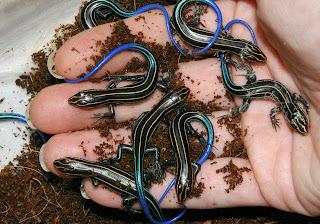
Hatchling broadhead skinks sport a brilliant blue tail but lose this color as they mature. Source: NSF-EID
Scincidae is just one of sixteen families of lizards worldwide but it contains some of the most beautiful species of reptiles. Florida is blessed (yes, blessed) with at least seven species of skinks, with one being divided into five sub-species. Three of the five sub-species of the mole skink have “protected” status under state or federal laws.
Several of our native skinks in the Panhandle are challenging to identify at first glance, particularly during their younger years. The five-lined, southeastern five-lined and broadhead skink are all striped and have blue tails as youngsters, hence the origin of the frightening title for this article. According to folklore, these animals have the ability to deliver a painful sting with their tail. Well, as a lifelong reptile enthusiast, I have had the experience of catching many young, blue-tailed skinks without any stings.
Now, back to the question of whether or not these blue-tailed skinks are poisonous. From everything that I have read, there is no scientific evidence that skinks are inherently toxic when eaten by other animals. It is theorized that they could potentially harbor Salmonella bacteria but I have never heard of a documented case of this either. Many people hold the belief that when a skink in eaten by a dog or cat, it causes the animal to hold its head cocked and wander off to one side when walking. Veterinarians refer to these symptoms as vestibular syndrome and often cannot diagnose a cause. Vestibular syndrome is related to the inner ear or the parts of the brain that control balance and a sense of orientation to gravity. Our family witnessed this once with a beagle that we had and it lasted for several weeks but gradually improved to the point of normalcy. We did not witness her eating a skink, although she could have. However, there are many other more likely causes for this behavior including, inner ear infections, cysts or tumors, head trauma, parasites, etc. I suspect that inner ear issues are a common cause.
The largest species of skink in the Southeastern U. S. is the broadhead (or broad-headed) skink, reaching lengths of nearly thirteen inches. When mature, these skinks lose the blue tail and most of their striping to become a tannish brown. Males are larger than females and have a reddish color on the head, which intensifies during the breeding season. If you want to identify this species as a juvenile, you will need to look at the scales on the underside of the tail to separate it from the two species of five-lined skinks that inhabit our area. The central row of scales will be significantly wider than the other rows on either side. Broadheads have powerful jaws and will bite if harassed. If you want to see two males engaged in epic combat, give a watch to this YouTube link: https://www.youtube.com/watch?v=Z8qbexnZWew . Their stamina is truly amazing and they definitely come out with some battle scars.
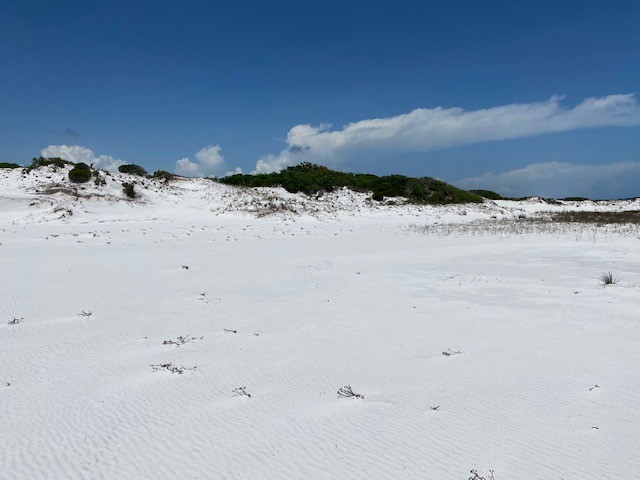
by Rick O'Connor | May 13, 2022
It is mid-spring and time of nesting for much of the wildlife in the area. It is also noticeably warmer than our previous hikes. Due to my work schedule, and the surveys for other nesting activity, I did this hike earlier in the month and later in the day, than I typically would have. I began my hike at 1:00pm – near the hottest part of the day, and not the best time to see wildlife, but I definitely wanted to get a hike in this month and so this is when I could.
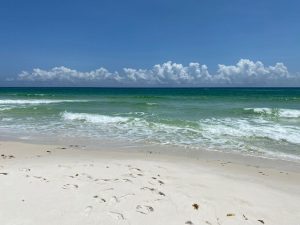
The Gulf was relatively calm on this early afternoon in spring.
It was warm. On this day it was 83°F and there was a light breeze from the southeast. On the previous hikes I needed my fleece. Though I had it in my backpack, I did not need it today. My hike was at Big Sabine and as usual, I began on the Gulf of Mexico. The first thing I noticed when I crossed over the boardwalk was the number of people. I usually hike in the early morning or late afternoon and see few humans. But at mid-day the beach was full of people, and I probably looked strange walking among them with my long pants, long sleeved shirt, and boots. The second thing I noticed was mats of Sargassum on the beach.
Sargassum is a floating brown algae we see in the warmer months in our part of the Gulf. It is first an algae, not a true plant. Algae lack roots, stems, and leaves. They produce no cones, fruit nor flowers with seeds. They are nonvascular, meaning they lack a system of vein-like tubes that move water around the plant. Plants usually do have these tubes. They are not called arteries and veins as they are in animals, but rather xylem and phloem. Because algae lack this circulation system, they live emersed in the water. Since they lack true roots they anchor to hard substrate, like rocks and coral, using a suction type apparatus called a holdfast. The flexible, herbaceous stipe, analogous to the stem, flows in the current extending their blades (analogous to leaves) into the light. Like plants, algae require water, carbon dioxide, and sunlight to photosynthesize their food. Because of this they need to live in relatively shallow water, and they need a rocky bottom to attach their holdfast to. We have little hard bottom and therefore less of the classic algae you read about in other parts of the world.
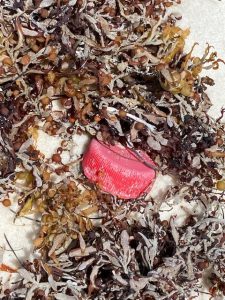
Notice the small air bladders on this Sargassum weed. These are used by the algae to remain near the sunlit waters of the open Gulf.
Sargassum has a different plan to deal with this problem. They float. When you look at this seaweed on the beach you will notice they have numerous small circular air bladders called pneumatophores. These air bladders allow Sargassum to float in the sunlit waters of the Gulf and not worry about how, or where, they would attach their holdfast.
Large mats of Sargassum can be found floating out in the open Gulf and these mats provide a fantastic habitat for many small and large marine creatures. There are sargassum crabs, sargassum shrimp, and even a sargassum sea horse. There is a small filefish and a frogfish known as the sargassum fish. It is the target for baby sea turtles that successfully made it from the beach, through the surf, and into the open Gulf without being consumed. Here they will live and feed for many months at which time they are large enough to venture back out. Larger fish often seek out these mats searching for food, and fishermen seek the mats knowing that larger fish are probably in the area.
These mats of Sargassum get caught in the large ocean currents and find their way to the middle of the Atlantic. Here the ocean is calm, like the eye of a hurricane, and huge mats of Sargassum can be found piled up. Christopher Columbus found this massive expanse of Sargassum while crossing the Atlantic. Because it was calm here, and the Sargassum so thick, his ships became becalmed and he noted in his log to avoid this place, which was then called the “Sargasso Sea”.
On today’s hike there was quite a bit of this seaweed washed ashore. Most of the marine life living in the seaweed sense the waves and the impending beaching, and jettison for mats further offshore. So, you usually do not find many creatures in the seaweed washed ashore, but sometimes you do. You can take a small dip net out deeper and grab some still floating and you may have better luck. Today, I explored what was washed ashore and did not find much. I did find a lot of plastic, and those who study Sargassum ecology will tell there is a lot of plastic debris caught up in the Sargassum mats. Today I noticed a lot of bottle caps. Not many bottles, but lots of bottle caps. As many others do, we encourage everyone to dispose of the garbage properly. I read this week of a manatee found near Mobile Bay earlier this year who died of cold stress but had swallowed a plastic bag, which was caught in his throat. Marine debris kills. Please dispose of your trash properly.
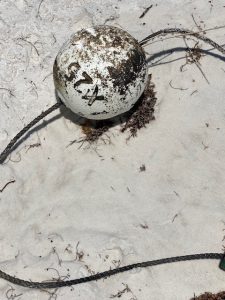
This crab pot float was one of several debris items washed in with the sargassum.
Heading inland to the dune field I heard sirens. The beach patrol was answering a call. I am not sure where, nor what the issue was, but these again are sounds I do not usually hear when hiking early and late in the day. There are currents in the Gulf that can suck you out to sea, and each year we have visitors drown not knowing where these currents are, or how to get out of them if they are caught in one. Pay attention to the colored flags and be careful. I never saw, nor heard, an ambulance follow the beach patrol. So, I am guessing everyone was okay on this call.
The dune field on this May afternoon was warm. There was a light breeze from the southeast that kept things from getting too warm, but it was warm none the less. As we move closer the hot days of summer the wildlife will move more at dawn and dusk, as well as in the evening. I was not expecting to see a lot on this hike.
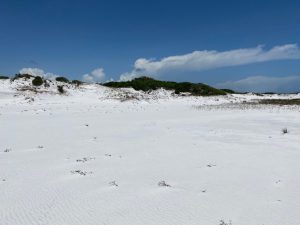
This flat area of the dune field was quite warm on this afternoon and made me think of crossing a desert.
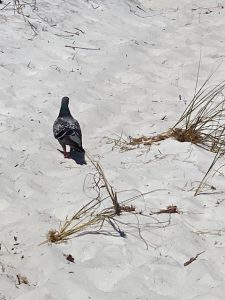
This was an unusual site, a pigeon walking in the open dune field.
As always you can see what has been moving by searching for tracks and tracks, I did find. Many of them were human, indicating the tourist season is upon us, but there were tracks of animals as well. There were plenty from our friends the raccoon and armadillo. I did notice more raccoon tracks this month. I and my volunteers who survey nesting beaches notice more raccoon tracks this time of year looking for eggs. I also noticed more snake tracks on this hike, they too are mating and moving much more. The lizard tracks were fresh, and I have noticed these moving during the warmer parts of the day and their tracks running across the dune face told me they were very busy that day.
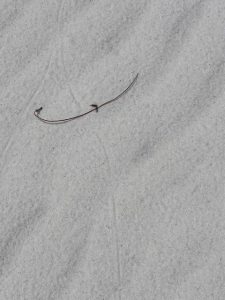
This straight line the sign of a tail drag by a lizard, most likely the six-lined skink.
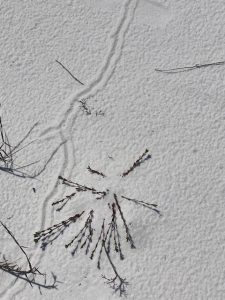
Many who visit the dunes of our barriers find these burrow looking trails. These are made by beetles.
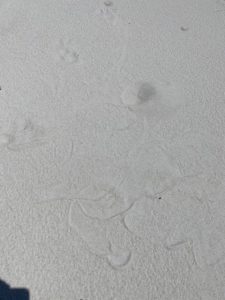
I followed this snake track until I found this – what appears to be a “tussle” the snake had with a possible prey.
Being spring you would expect flowers, and there were some, just not as many as you might expect. Most of them were white and were blooming on plants near the boggy areas of the swales. The conradina that blooms more in the winter, was done and the blossoms were gone. I did see the early stages of the magnolia flowers trying to come up, but the bright green shoots of new growth on the pines were not visible. There were bees, lots of bees.
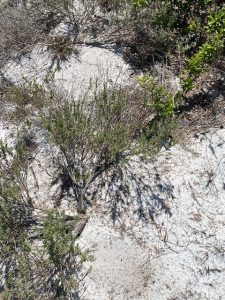
The lavender blossoms of the false rosemary, which appeared in winter, are now gone.
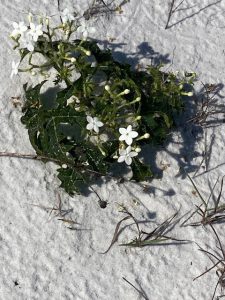
White flowers were common on this spring afternoon. Such as this one on the spiny bull nettle.
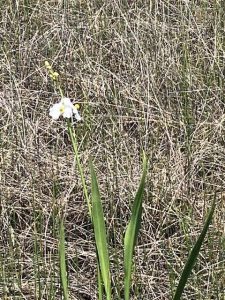
Another white flower is seen on this Sagittaria growing in one of the swales between dunes.
I hiked through a small pine scrub area thinking I might someone in the shade avoiding the heat of the day but did not find anything. I went along the edge of the tertiary dunes where they meet the maritime forest looking for the same thing. Nothing, but there were tracks. The cactus seemed to be more abundant this month.
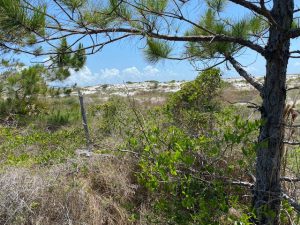
The pine scrub offered one of the few places with shade.
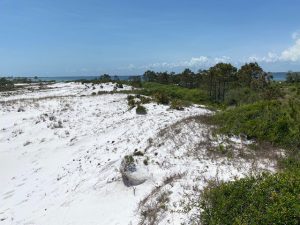
The dune field of a Florida panhandle barrier island.
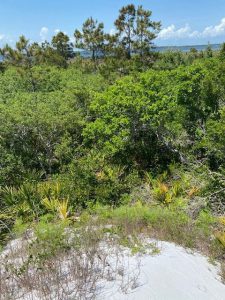
From atop of one of the higher dunes you can see the steep drop towards the marsh.
Along the ridge between the maritime forest and the salt marsh is where I found the otter slide last month. I did not see any evidence of otters today. The bird action was slower today as well. Maybe because of the heat they too had settled somewhere. I did not see an osprey, which is unusual.
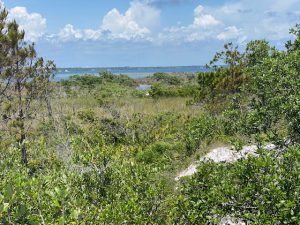
Big Sabine as seen from atop one of the larger dunes.
As I reached the beach of the Sound, I did notice a LOT of digging by armadillos. They had been very active. There were no snakes or marsh rats. There were again people, these were on jet skis. There were a few fishing from small boats. With no rain over the last week or so the visibility in the Sound was amazing, but I only saw one small blue crab. No hermit crabs and not any fish. However, the lagoon of the marsh the killifish, also known as bull minnows, were abundant and the males all aglow with their iridescent blue colors of breeding season. The males were chasing each other all over the tidal pools and open water of the lagoon designating their territories for current breeding that would follow. I did notice more crows than I usually do and what made me catch their attention was the constant calling at me and the hovering over me suggesting they too were breeding, and an active nest was nearby.
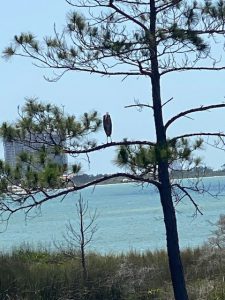
A blue heron is seen sitting in a pine overlooking Santa Rosa Sound.
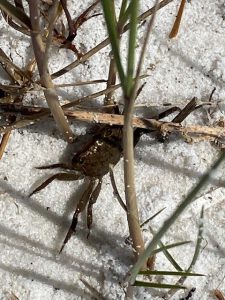
A small Seserma crab is seen hiding under grass along the beach of the Sound.
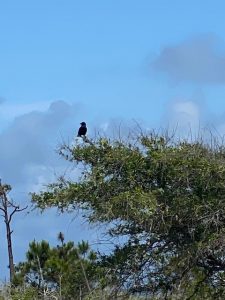
The crows were numerous and active on this spring afternoon.
I was not expecting much hiking in the middle of the afternoon, but it is always good to do these just to see what is moving. I hope to do another hike this month either early in the morning or late in the afternoon. Maybe we will see more.
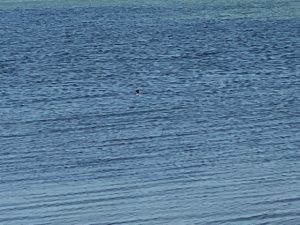
It may be hard to see, but there was a small duck enjoying the Sound.
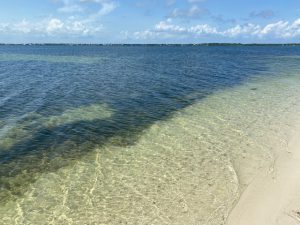
With little rain over the last few days the water clarity was excellent and you could see the seagrass very well.

by Rick O'Connor | Apr 21, 2022
It is now spring, and wildlife is beginning to stir more. However, on this April day another cold front had just past the area and the morning temperature was 59°F. To add to this, there was a strong west wind that made it feel colder. Despite the fact it was an early spring morning in Florida, I had my fleece on and was dubious that I would see any reptiles.
This month’s hike was out at Big Sabine near Park East. The Gulf of Mexico was churning like a washing machine due to the passing front and the beach had a sharp scarp to it. There were a few plovers out trying to probe the sand for food, but not much else. Usually after hard winds you will find an assortment of things washed up on the beach but there was little really, possibly removed by the storm. There were however signs of digging by humans. It is now sea turtle nesting season, and we remind folks that these large holes can be a real problem for the mothers trying to nest. Please fill them in before you leave the beach.
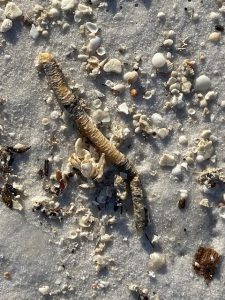
Diopatra are segmented worms similar to earthworms who build tubes to live in. These tubes are often found washed up on the beach.
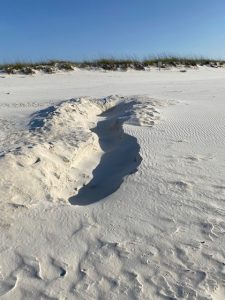
Large holes like this can be problematic for many island wildlife species – like nesting sea turtles. Please fill them in when you leave for the day.
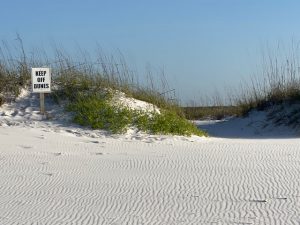
“Blow outs” are formed by people walking over the dunes. They will increase the erosion of these dunes and enhance flooding during storms. Please cross over on boardwalks.
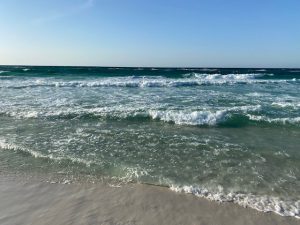
The Gulf of Mexico was churned up due to the passing cold front.
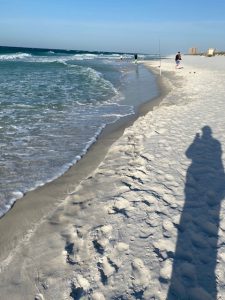
Beach scarps are formed during heavy surf changing the dynamics of the beach for creatures living there.
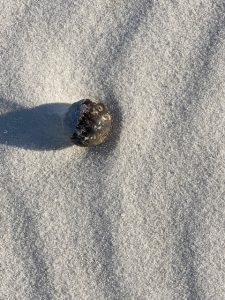
“Sea Beans” are seeds of tropical plants that wash ashore this time of year. Most do not germinate and those that do are usually on a high energy beach and do not survive.
As you head north into the dune fields the wind typically slows, but this morning it was blowing plenty hard, and I was getting “sand blasted” at some points. Not the best day to find wildlife. The sun was out and I decided to check the leeward side of shrubs and bushes, but had no luck.
One thing I did find was the sandhill milkweed in bloom. This plant is host to the monarch butterfly caterpillars and produces a mildly toxic “milk” which the caterpillars accumulate making them toxic to birds. This toxin is carried on to the adult butterfly stage and many birds learn to avoid butterflies with the monarch coloration because of the bad taste. Though I saw lots of milkweed, it was too windy for the butterflies.
The blooms of the false rosemary, which appear in late winter, had all fallen but it was obvious that the pine trees had release their pollen. Most of the scrubby pines in the dunes had new growth on them.
There were several ephemeral ponds scattered amongst the dunes. All had water in them from the recent rains and I was hoping to maybe find a basking snake or singing frog. No luck on either. There were damp areas where water had recently been, and the carnivorous sundews and spore producing club moss, known as ground pines, were doing very well.
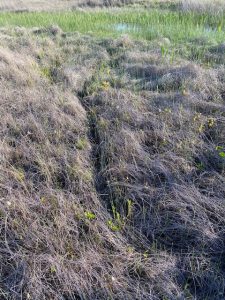
The path used by wildlife to reach the ponds of the dune field.
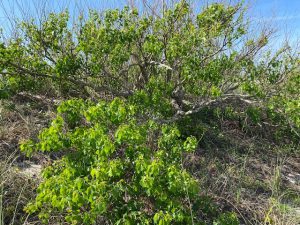
Two invasive Chinese tallow trees were found growing in the dune field. These will be removed.

Devil’s Joint is a common cactus in the dunes. Wear shoes when exploring!
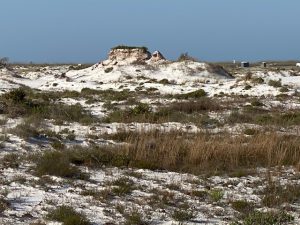
The high winds of the beach can form some interesting dunes. This one resembles the mesa’s of the American southwest.
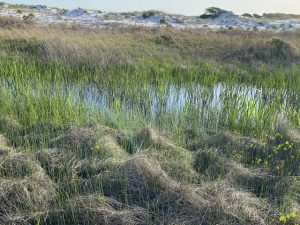
There are numerous freshwater ponds in the low areas of the dune field. Many of them are ephemeral.
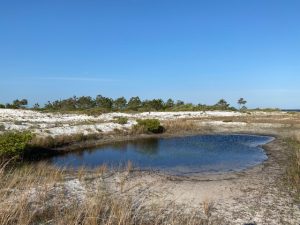
Freshwater ephemeral pond.
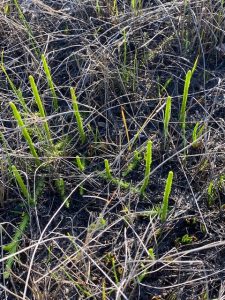
Ground pine is a type of club moss found in the wet-damp areas of the dunes.
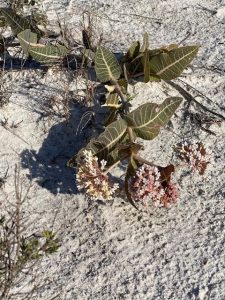
The sandhill milkweed is bloom this time of year.
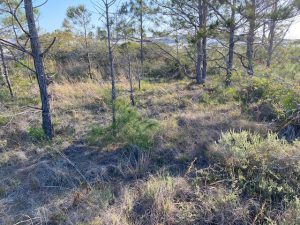
Pine scrub areas like this are found in the dune fields and are great places to find snakes and lizards.
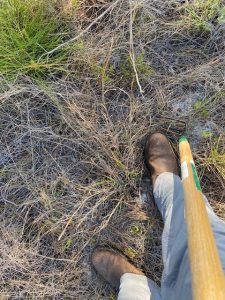
Since some of our snakes are venomous, it is recommended you wear good boots and have a hiking stick to move logs and high grass before stepping in or over.
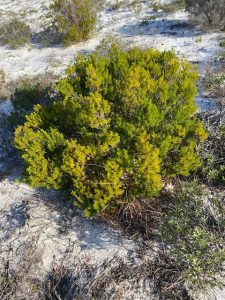
Seaside rosemary produces a wonderful smell that reminds many of the beach.
As I moved from the dunes into the maritime forest, I was expecting to see birds. I did, but not many. Most were small woodland birds I could not identify, and there was an osprey flying over briefly, but for the most part the bird action was slow today – again, probably due to the high winds. I was again hoping to maybe find a basking snake on the sunny leeward side of a bush or fallen tree but had none. I did find a common parasitic plant that was becoming more common this time of year. It is called “love-vine” or dodder. This yellow-colored string looking vine lacks chlorophyll and wraps around host plants to remove much needed nutrients. It begins to appear this time of year and is not restricted to the beaches. I have seen it 10 miles inland.
One thing that was very evident in the maritime forest was sign of armadillos. Their tracks and digs were found everywhere. I did locate a few burrows and found even more along the beach of the Sound. These animals are very abundant on this island I am curious as to what predators they have and how their populations are controlled. They can be found day or night and dig frequently looking for grubs and other invertebrates to eat. Whether they seek out turtle or bird eggs I do not know. More on this guy next month.
I will add that I did see tracks of raccoons who do eat turtle eggs and also what I think was a “slide” of an otter. The number of otter encounters has increased in recent years. Individuals have been seen not only on the beach but around Bayou Texar and Project Greenshores. These are very elusive animals and produce a high pitched “chirp” or “bark” when approached. I have seen them near Ft. Pickens on a couple of occasions in the ponds. There are the old hatchery ponds at Big Sabine, and it was there that I found the “slide”. These slides are used by the otters to slide into the water. I have seen video of them exiting the water, sliding back in, only to repeat this as if they were playing like kids – and I think that is what they are doing… playing. Otters are the largest members of the weasel family, mustelids, and pretty cool.
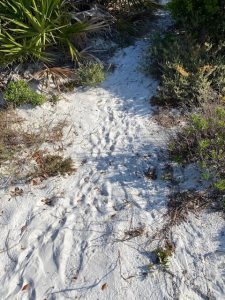
Many creatures use the same trails we do. This is a good place to look for tracks.
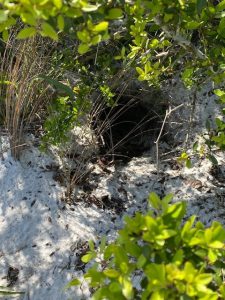
Armadillos are all over the island. This is a burrow of one.

The digging of armadillos can be found everywhere as well.
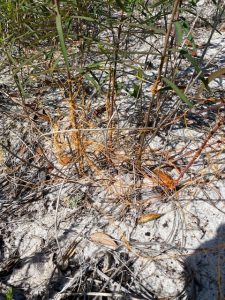
Dodder (or “love vine”) is a parasitic plant that begins to appear this time of year.
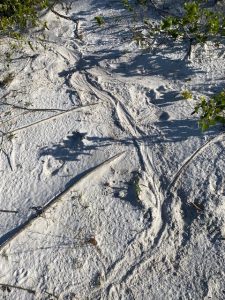
This is what I think to be an otter slide. Though I could not find tracks to confirm, I have seen them build and use these before.
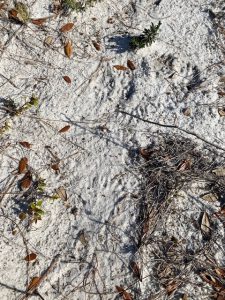
Raccoons are common all over the island.
The marsh of Big Sabine was pretty quiet on this windy day. I did see two Canadian geese walking along the shore. I recently saw several nesting on an island in Okaloosa County and was told they were now year-round residents. I am not sure whether these were residents to Big Sabine or not, I had not seen them before, but will note this as this series continues this year.
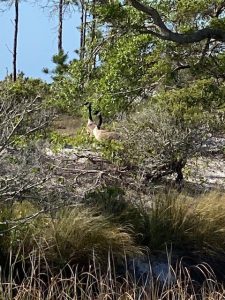
Canadian geese are becoming residents on some islands along the panhandle.
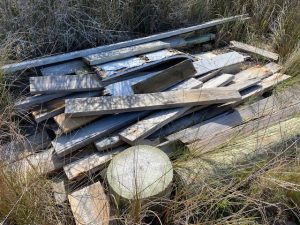
Wood piles like these can be good habitat for some beach wildlife.
The beach of Santa Rosa Sound was quiet as well. Again, I probed around to seeking a basking snake, a nesting terrapin, or maybe a nesting horseshoe crab (it was a spring tide day) but found nothing. There are piles of wood gathered by locals cleaning the beach and these actually make good habitat for some wildlife. I poked around in them but did not find anyone today. This was also where I found most of the armadillo burrows. Why they preferred this over the forested areas I am not sure. There may be many more in the forest that I just did not see. The spring tide was rising and much of the beach was exposed but I saw no fiddler crabs or other creatures and there was nothing swimming nearshore in the grass beds. Again, the lower temperatures and high winds I am sure had everyone in a warmer calmer place.
Despite little wildlife today it was a great walk and despite the high winds, the weather was actually nice. It is spring and nesting should be going on across the island. We will visit Ft. Pickens in May and see what is going on then.
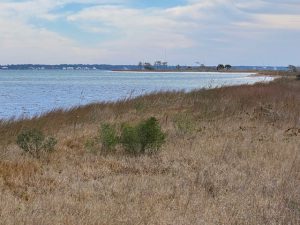
Santa Rosa Sound.
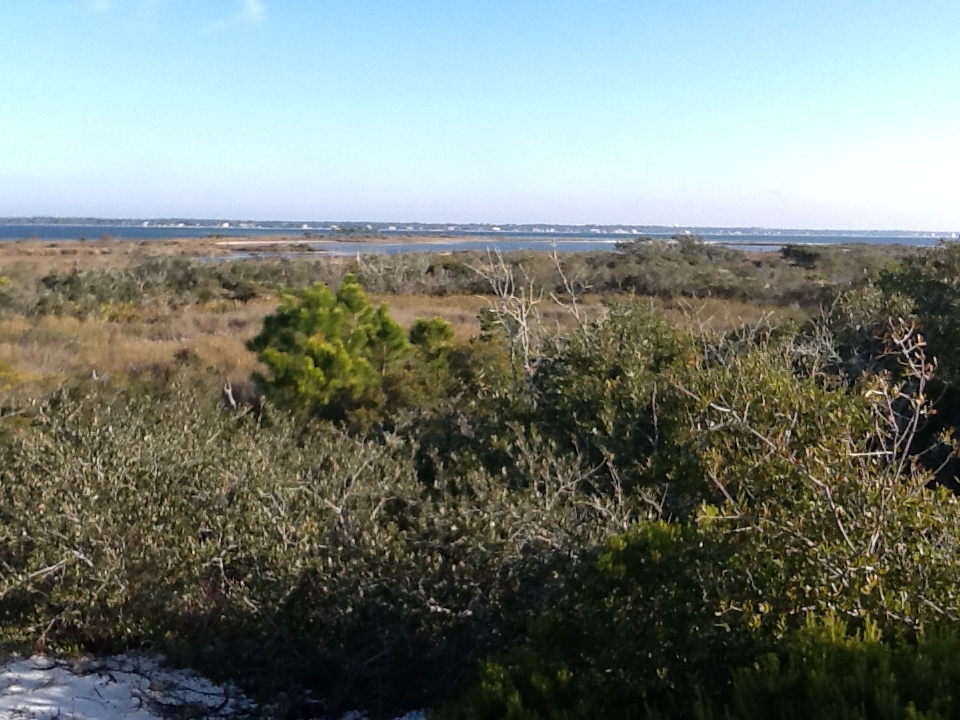
by Rick O'Connor | Mar 24, 2022
When exploring local coastal environments, the salt marsh is one not frequently visited by residents. When first seen, the large field of grass appears inviting. But when you reach it appears impenetrable, full of bugs and snakes, and there must be an easier way around.
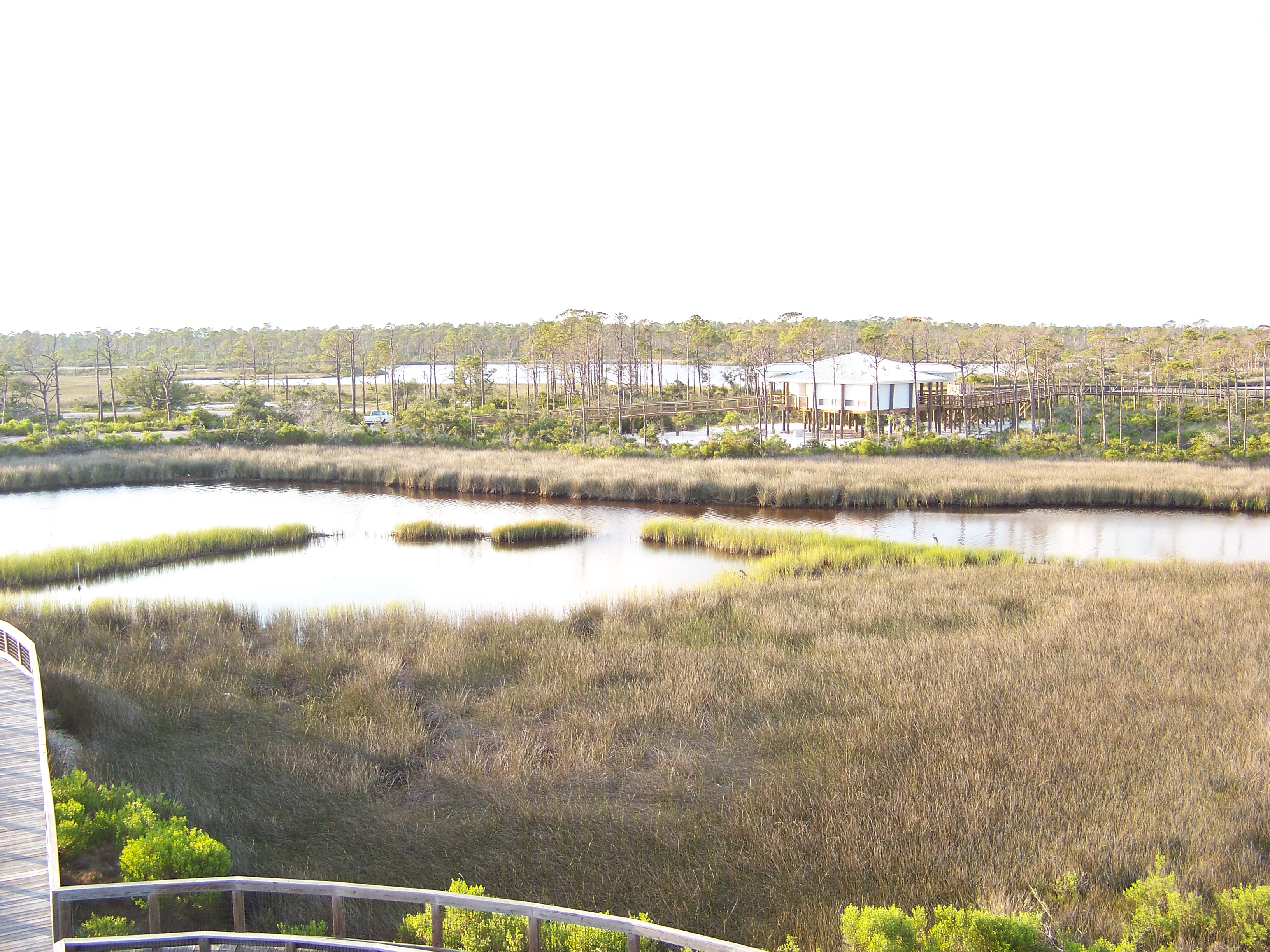
The Salt Marsh – the land of the wet and Muddy
Photo: Molly O’Connor
There are three ways to access a salt marsh. One, to just begin walking into the field of grass, pushing your way through like a boat on the ocean. Second, using a trail cut but someone else, that meanders its way to the high ground or open water. And third, from the open water following a creek. This can be done on foot or by a paddle craft.
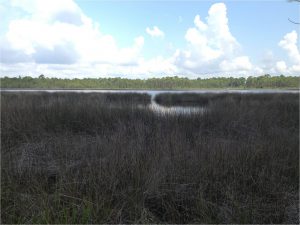
Entering the salt marsh can be tricky.
Photo: Rick O’Connor
If entering by foot into the field of grass, the explorer is first met with a tall grass with a pointed end – black needlerush. This rather stiff, thin, cylinder-shaped grass has a good name, the pointed end is sharp and hurts as you begin to move it out of the way with your forearms. When in college I was told “you might want to wear jeans”. I did not see wearing jeans in the summer heat as a good idea so, chose not to, but understood quickly why they recommended it. Honestly, I am not sure it would have helped anyway. Needlerush pokes your arms, legs, and care must be taken and avoid bending over to pick something up, else you will get a poke in the face or eye.
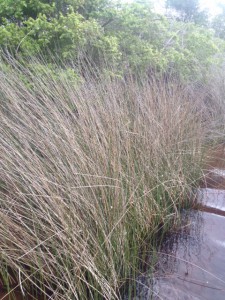
Black Needlerush is one of the two dominant plants of our salt marshes. Photo: Rick O’Connor
After quickly meeting black needlerush you meet the mud. They do not call it the land of the wet and muddy for nothing. They mud is like pudding and some sections feel like there is no solid ground. This mud is a slate gray color, smells like rotten eggs, and you can sink into it up to your knees in places. Shoe selection in a place like this is important. Many an explorer has placed their shoe covered foot into the mud only to bring up a shoeless foot the next step. Shoes that can tied or synched to the foot are best. They need a good thick bottom to protect the foot from shells, like oysters. I will tell you “crocs” are not what you want.
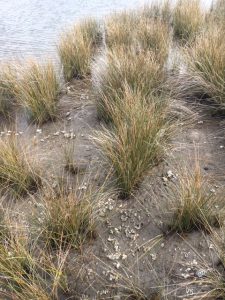
The sediment in a marsh is not always as solid as it looks.
Photo: Rick O’Connor
The rotten egg smell is the gas hydrogen sulfide, produced by bacteria breaking down organic material trapped within the marsh. And much becomes trapped here. By definition a marsh is a wetland that is dominated by grasses rather than trees. Being a wetland, it is low in elevation and holds water either from rainwater run-off or from the incoming tide. As the water recedes, leaf litter, animal carcasses, and other debris become trapped in the marsh. In fact, the ability of the marsh to hold this decaying layer of mud plays an important role in keeping the open water clear.
As you labor your way across the marsh, pulling each footstep through the mud while moving the sharp grass, you may see signs of life. Most animals have trouble walking through the grass and mud as well and choose another route. But the density and biomass of the open marsh is impressive. Trying to count the blades of grass would be like trying to count the stars in the sky. It is a very biologically productive place. One creature you may encounter is the bird known as the clapper rail. This brownish bird blends in well in the sea of grass and often builds their nest here. When you come upon them, they will let out a loud squawking sound that will honestly terrify you at first. Sometimes they fly, sometimes they move to a new location, sometimes they hold their position and continue to try and scare you away.
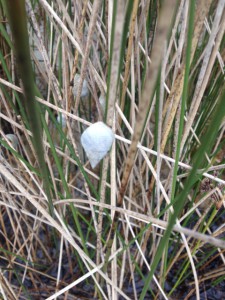
The marsh periwinkle is one of the more common mollusk found in our salt marsh. Photo: Rick O’Connor
Another common creature seen is the marsh periwinkle. This small white snail is often seen on the blades of needlerush. As the tides rises, so does the periwinkle, crawling up the grass to avoid predators like the blue crab and diamondback terrapin. At low tide they are on the surface of the organic mud feeding on bits of decaying material. Again, caution if you are going to bend over to look for them. You may get a needlerush in the eye!
There are times as you are crossing you will come to an open area with little or no grass. These are known as salt pans and are areas with lower elevation that the surrounding marsh. Saltwater lies here during high tide and low. As the pool of water evaporates the salinity of the remaining water increases and becomes too salty for most plants to grow. It becomes a “dead zone” within the marsh. There are a few salt tolerant plants that do grow here. You may see the tracks of other creatures exploring, like raccoons, but otherwise it is a break for you from the constant shoving of needlerush and you step in there.
Occasionally you will cross the opposite in elevation. A high ridge of quartz sand where small shrubs like salt bush or even a small oak can be found. These little oasis’s can be places where other travelers of the marsh will rest. Fiddler crabs, cactus, and maybe even a basking snake could be found here.
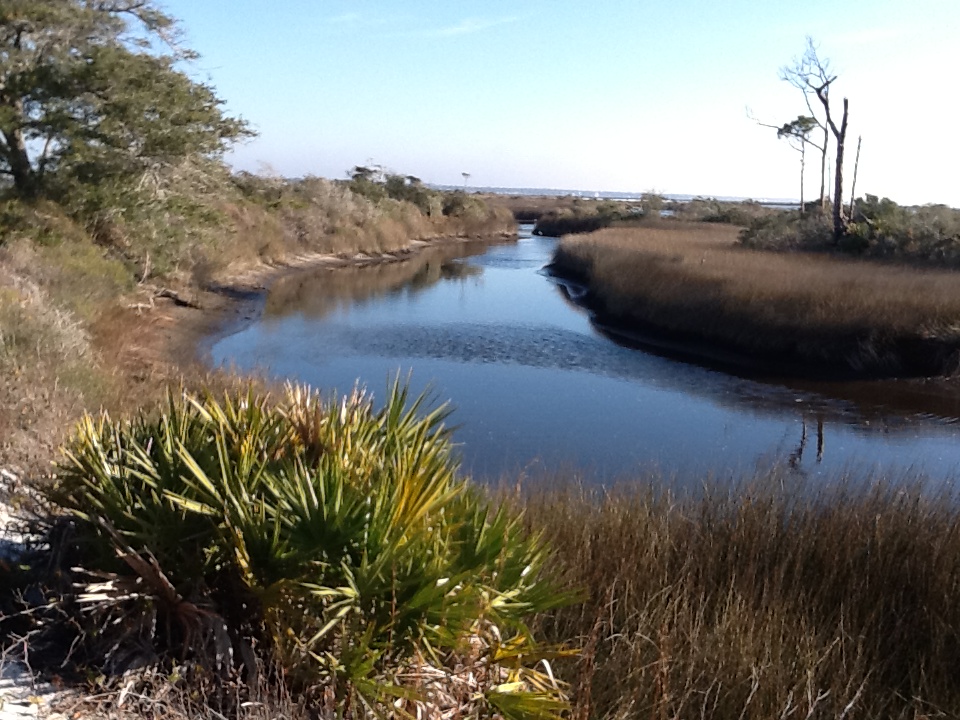
A finger of a salt marsh on Santa Rosa Island. The water here is saline, particularly during high tide. Photo: Rick O’Connor
There are times when you will cross a creek. These creeks meander their way through the marsh and to the open water. Many travelers, for obvious reasons, choose to follow these routes. Some creeks are shallow and full of mud where you may sink above your knee. Others are a bit deeper and have more solid bottoms of sand. Walking through the water can give some relief from the needlerush. Here you will see several species of fish. Most are killifish or mullet, but as you get closer to the open water you might find redfish or flounder. It is much easier to see the periwinkles here. You will also notice the ribbed mussels anchored near the base of the needlerush. There are oyster clumps scattered here and there and huge colonies of fiddler crabs. The creeks are good hunting grounds for the stilted legged birds such as the great blue heron and American egret. Clapper rails often nest along the creek edges and there is a lot of sign of raccoons and sometimes otters.

The “snorkel” is called a siphon and is used by the snail to draw water into the mantle cavity. Here it can extract oxygen and detect the scent of prey.
Photo: Franklin County Extension
The crown conch is a frequent visitor to the creeks. This predatory snail moves slowly across the sand and mud seeking other mollusks to feed on. Often you will find their shells not inhabited by them but rather the striped hermit crab, a scavenger in this world.
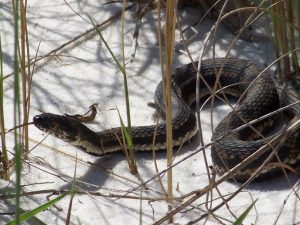
The nonvenomous Gulf Salt marsh Snake.
Photo: Molly O’Connor
Many fear the marsh due to its reptile community. Over the years of leading hikes here I have heard “are there any snakes here?”. There is only one resident of the salt marsh – the Gulf salt marsh snake. This is a nonvenomous member of the watersnake group known as Neroidia and are more nocturnal in habit. That said, the venomous cottonmouth has been seen here. They are most often seen on one of the high sandy banks, coiled and waiting for potential prey to swim by.
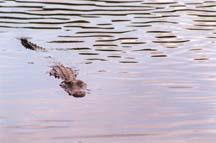
Alligator
Photo: Molly O’Connor
Alligators will venture into salt marshes, but I have only seen few in my years of exploring them in the Pensacola area. They tend to be afraid of people and want to avoid us. Once I saw one in a sandy area before I entered the marsh. It was pointing left with one foot off the ground and not moving – it was frozen in space. I had learned that animals tend to go through what I call the “3 Fs” when they detect a predator. Freeze – Flight – Fight. This one was at F1 – freeze. It thought I was a predator and just as well. If I tried to approach it, theoretically it would have moved to F2 – flight, and would have made a hasty escape. But I chose not to test that.
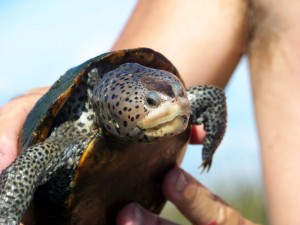
Mississippi Diamondback Terrapin (photo: Molly O’Connor)
There is a resident turtle here known as the diamondback terrapin. However, it is very elusive and difficult to find. It is the only resident brackish water turtle in North America. Though I have seen terrapins in the water, and more rarely on the beach, I do find evidence of their presence by tracks on the beach and nests that have been predated by raccoons. I did once see one basking on a log.
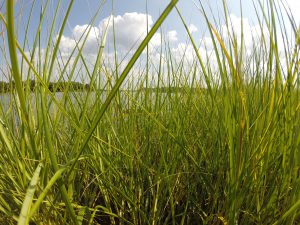
Smooth cordgrass
Photo: FDEP
If you follow the creek, you will eventually reach open water. Here the marsh converts from a sea of black needlerush to a zone of shorter, greener, more flexible smooth cordgrass. The cordgrass is home to many of the creatures we have mentioned. Killifish, crabs, and snails are abundant. The silt birds frequently this zone hunting for their prey, and you might find additional clams and snails. You might find more open water species as well, like gulls, sand pipers and plovers, and maybe a horseshoe crab.
Though the road is tough, the experience is unique and worth the trip. Many prefer to enter the marsh using a known trail or a paddle craft in the creek. There is a lot less needlerush to poke and mud to sink in doing it this way. However you visit, it is an amazing place. The land of the wet and muddy.
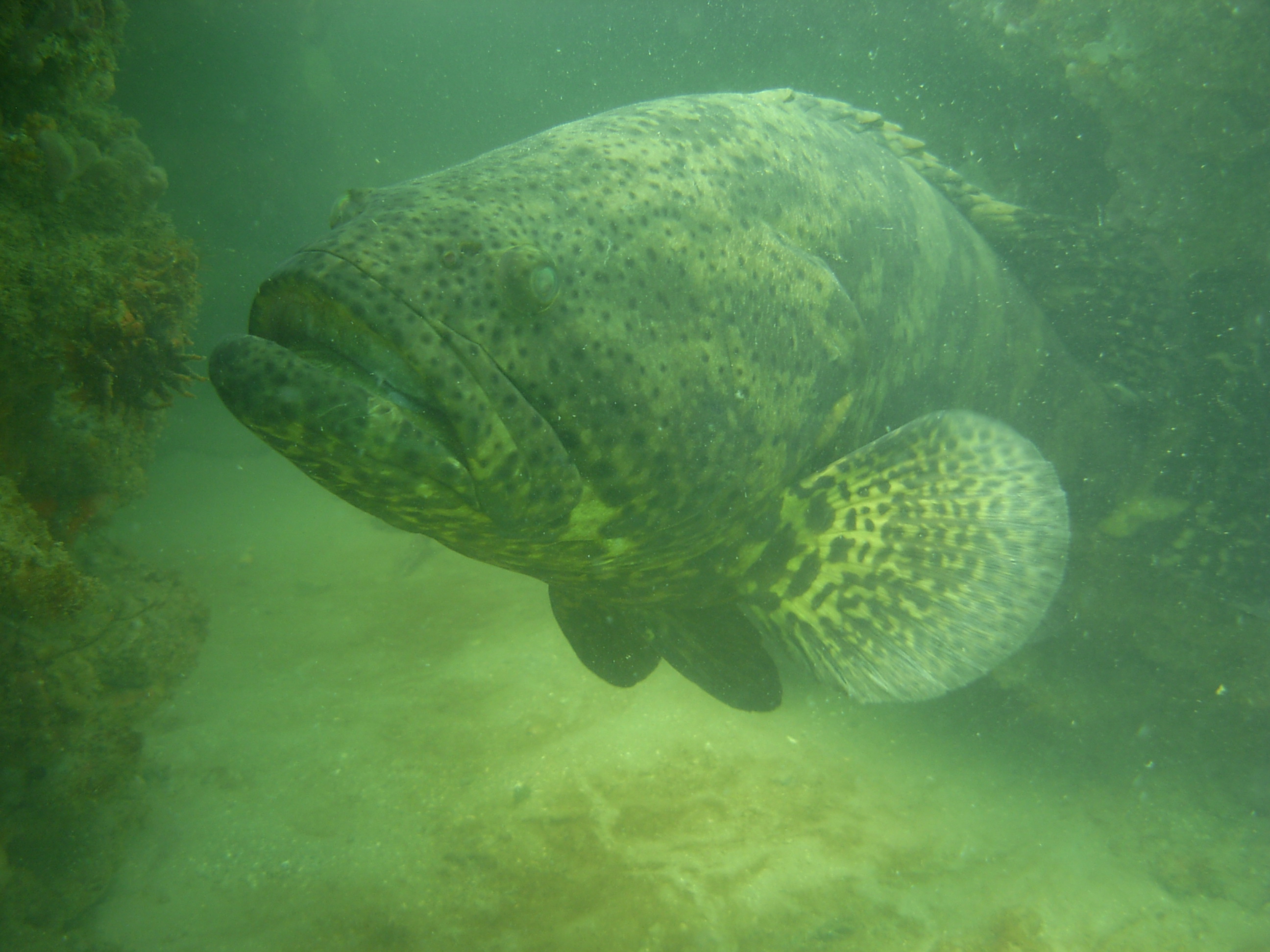
by Rick O'Connor | Mar 18, 2022
When you look over the species of sea basses and groupers from the Gulf of Mexico it is a very confusing group. Hoese and Moore1 mention the connections to other families and how several species have gone through multiple taxonomic name changes over the years – its just a confusing group.
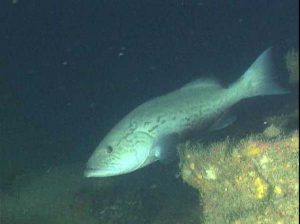
Gag grouper.
Photo: National Oceanic and Atmospheric Administration
But when you say “grouper” everyone knows what you are talking about, and everyone wants a grouper sandwich. This became a problem because what people were serving as “grouper” may not have been “grouper”. And as we just mentioned what is a grouper anyway? The families and genera have changed frequently. Well, this will probably get more technical than we want, but to sort it out – at least using the method Hoese and Moore did in 1977 – we will have to get a bit technical.
“Groupers” are in the family Serranidae. This family includes 34 species of “sea bass” type fish. Serranids differ from snappers in that they lack teeth on the vomer (roof of their mouths) and they differ from “temperate basses” (Family Percichthyidae) in that their dorsal fin is continuous, not separated into two fins. These are two fish that groupers have been confused with.
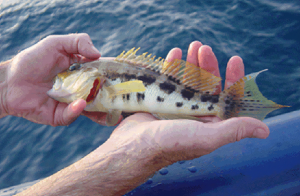
Banked Sea Bass.
Photo: National Oceanic and Atmospheric Administration.
We can subdivide the serranids into two additional groups. The “sea basses” have fewer than 10 spines in their dorsal fin. There are 10 genera and 18 species of them. They have common names like “bass”, “flags”, “barbiers”, “hamlets”, “perch”, and “tattlers”. They are small and range in size from 2 – 18 inches in length. Most are bottom reef fish with little commercial value for fishermen. Most are restricted to the tropical parts of the Atlantic basin but two are only found in the northwestern Gulf, one is only found in the eastern Gulf, and one has been found in both the Atlantic and Pacific. The biogeography of this group is very interesting. The same species found in both the Atlantic and Pacific suggest an ancient origin. The variety of serranid sea bass suggest a lot of isolation between groups and a lot of speciation.
The ”groupers” have 10 or more spines in their dorsal fin. There are two genera in this group. Those in the genus Epinephelus have 8-10 spines in their anal fin and have some canine teeth. Those in the genus Mycteroperca have 10-12 spines in their anal fin and lack canine teeth. Within these two genera there are 15 species of grouper, though the common names of “hind”, “gag”, “scamp” are also used. Most of these are found along the eastern United States and Gulf of Mexico. Five species are only found in the tropical parts of the south Atlantic region, five are also found across the Atlantic along the coast of Africa and Europe, and – like the “sea bass” two have been found in both the Atlantic and the Pacific. They range in size from six inches to seven feet in length. The Goliath Grouper can obtain weights of 700 pounds! Like the sea bass, groupers prefer structure and can live a great depths. Unlike sea bass they are heavily sought by commercial and recreational anglers and are one of the more economically important groups of fish in the Gulf of Mexico.

The massive size of a goliath grouper. Photo: Bryan Fluech Florida Sea Grant
One interesting note on this family of fish is that most are hermaphroditic. The means they have both ovaries (to produce eggs) and testes (to produce sperm). Sequential hermaphrodism is when a species is born one sex but becomes the other later in life. This is the case with most groupers, who are born female and become male later in life. However, the belted sand bass (Serranus subligarius) is a true hermaphrodite being able to produce sperm and egg at the same time – even being able to self-fertilize.
For many along the Florida panhandle, their biogeographic distribution and sex do not matter. It is a great tasting fish and very popular with anglers. For those with a little more interest in natural history of fish in our area, the biology and diversity of this group is one of the more interesting ones.
Reference
1 Hoese, H.D., Moore, R.H. 1977. Fishes of the Gulf of Mexico; Texas, Louisiana, and Adjacent Waters. Texas A&M Press. College Station TX. Pp. 327.
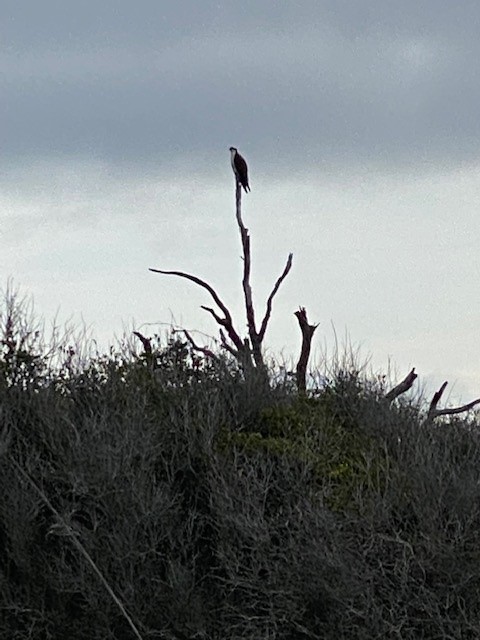
by Rick O'Connor | Mar 11, 2022
The month of March is the last of winter. For todays hike we returned to Gulf Islands National Seashore/Ft. Pickens where it was 63°F, overcast with a strong breeze from the northwest. A cold front is coming through to remind us that winter is not over yet. It was not 44°F as it was on our February hike but with the wind and cloud cover, it was a bit cool and not ideal for most wildlife to be out. But the ospreys were…
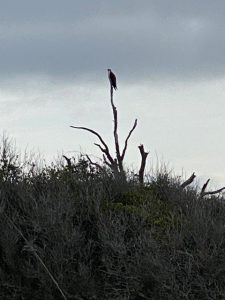
Osprey perched.
Photo: Rick O’Connor

An osprey pair building a nest on the chimney of the ranger station at Ft. Pickens.
Photo: Rick O’Connor
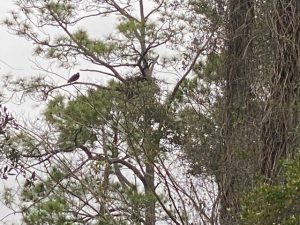
Another osprey pair with a nest in a large pine.
Photo: Rick O’Connor
They were everywhere. Building nests in live pines, dead snags, platforms built just for this, and on the chimney of the ranger station. Their sounds were everywhere – it is breeding season for them. The great blue herons were still nesting, we saw them first in January, but there are still a few around. American egrets were out as were numerous mourning doves. As with the colder February day, it was primarily bird action right now. I did see evidence of armadillos, and would guess other mammals were on the move, but did not see evidence of any others. The reptiles and amphibians are still missing – but should not be for long.
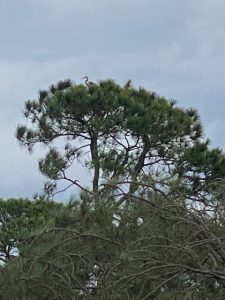
The herons began nesting in January. Some are still there.
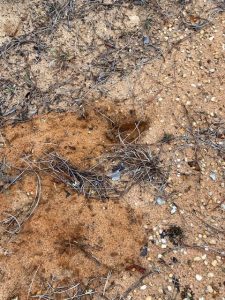
Evidence of armadillos digging.
The plant I know as beach heather, many call false rosemary, and has the scientific name Conradina, was in full bloom. After the hollies of the Christmas season, these are the plants I often see bloom first. Though I have seen bees around my home already, and wasps, I did not see/hear any insect movement this morning.
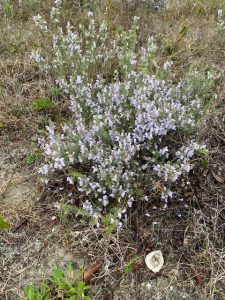
Beach heather (false rosemary) is one of the first plants to bloom on our islands.
The north beach (Pensacola Bay) was rough due to the northwest wind. It was difficult to see if anything was moving around in the shallows. There were a lot of shells on the shore. Two particularly caught my eye. The Florida Fighting Conch was pretty abundant, more than normal – and there were several scallops shells. There are two species locally, the calico scallop (often found in the Gulf) and the bay scallop (the estuarine version and the one of “scalloping” fame). Calcio scallops are often pinkish in color and often with spots. The bay scallop is usually gray in color. Those I saw this morning were all bleached white but, based on other variety of shells in the mix, I am thinking these were calcio scallops.
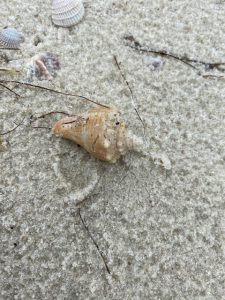
There were several Florida Fighting Conch shells on the beach this month.
There was very little marine debris today and no tracks of any kind seen. There was only one lone pelican spotted, maybe due to the high winds they settled somewhere else. Maybe they have moved off to smaller islands for breeding themselves, I am not sure.
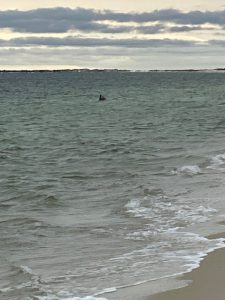
We only saw this one lone pelican today.
Though the wildlife has been more restricted to birds at the moment, the birding is excellent right now and the beach has relatively few people – it is a great time to take a hike out there.
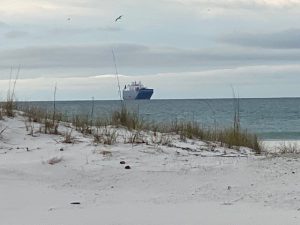
This large tanker awaits its turn to enter Pensacola Bay.
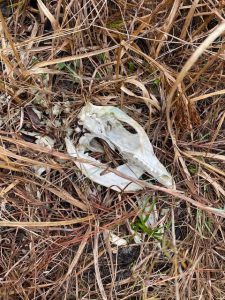
This skull found along the side of the side of the road is believed to be a raccoon.
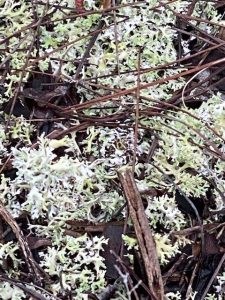
Lichen is an organism that is a partnership between algae and fungus. They were a brilliant white-green this month.
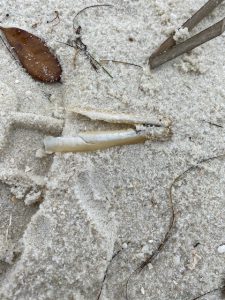
Razor clam shells are quite common along the shoreline.
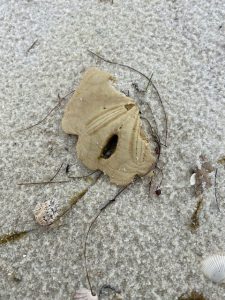
Sand dollars are not as common on the bay side of the island but there were several today.
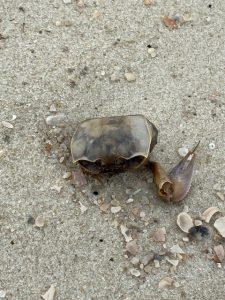
The remains of a ghost crab.
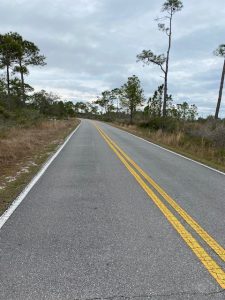
Believe it or not, walking along the road is a great spot to find wildlife.

















































































